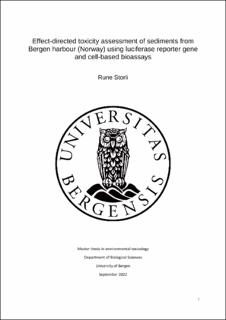| dc.description.abstract | Bergen harbour has been a historically polluted area in line with the harbours of many other major coastal cities in Norway and other countries around the world. With pollutants accumulating to toxic levels in organisms inhabiting these areas, the need for targeted and precise ways of remediating polluted sediments is necessary. To achieve this, a better understanding of the composition and bioactivity of the pollutants in the sediments is needed. Effect-based bioassays in combination with fractionation of sediment extracts and targeted and non-targeted chemical analysis can be used to identify the specific compounds responsible of mediating toxicity. Sediments in the inner part of Bergen harbour (Vågen) has previously been shown to contain discharges from factories and harbour activities. In this study, sediment extracts from this site were chemically fractionated into 10 individual fractions ranging from least polar to most polar by using mixtures of hexane, dichloromethane, and methanol in varying ratios. Luciferase-based reporter gene assays were then used to measure the activation of a selected set of stress-activated receptors from Atlantic cod (Gadus morhua) and zebrafish (Danio rerio) using the different fractions obtained from the sediment samples. The receptors assessed were Atlantic cod aryl hydrocarbon receptor 2 (gmAhr2a), androgen receptor alpha (gmAra), estrogen receptor alpha (gmEra), and zebrafish pregnane X receptor (drPxr), which were chosen based on previous work (Goksøyr et al, 2021). The gmAhr2a was activated by all the fractions assessed with the exceptions of the least- and most polar ones, which was in good agreement with the EROD assays showing a similar pattern of Cyp1A activity in PLHC-1 cells exposed to the same fractions. The drPxr receptor was selectively activated by two fractions of intermediate and high polarity, with little or no activation by the other fractions. With the gmAra receptor, most activation was observed by fractions from the higher end of the polarity gradient compared to the gmEra receptor where almost all fractions showed similar, but low activation. The general activation in both the gmAra and gmEra receptors were low compared to the controls. Results from the chemical analysis show that most compounds congregated in fractions 2, 3 and 4. This coincides somewhat with the activation of the Ahr receptors where fraction 4 activated the strongest. For the other receptors this is not the case and further chemical characterization of the fractions is ongoing. | |
